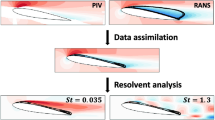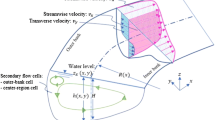Abstract
The objective of the present study is to investigate the pressure-strain correlation terms of the Reynolds stress models for the three dimensional turbulent boundary layer in a 30° bend tunnel. The numerical results obtained by models of Launder, Reece and Rodi (LRR), Fu and Speziale, Sarkar and Gatski (SSG) for the pressure-strain correlation terms are compared against experimental data and the calculated results from the standard k-ε model. The governing equations are discretized by the finite volume method and SIMPLE algorithm is used to calculate the presure field. The results show that the models of LRR and SSG predict the anisotropy of turbulent structure better than the standard k-ε model. Also, the results obtained from the LRR and SSG models are in better agreement with the experimental data than those of the Fu and standard k-ε models with regard to turbulent normal stresses. Nevertheless, LRR and SSG models do not effectively predict pressure-strain redistribution terms in the inner layer because the pressure-strain terms are based on the locally homogeneous approximation. Therefore, to give better predictions of the pressure-strain terms, non-local effects should be considered.
Similar content being viewed by others
References
Bradshaw, P. and Terrell, M. G., 1969,The response of a turbulent boundary layer on an infinite swept wing to the sudden removal of pressure gradient, NPL Aero Rep. 1305.
Durbin, P. A., 1993,On modeling three-dimensional turbulent wall layers, Phys. Fluids, A, 5 (5).
Flack, K. A., and Johnston, J. P., 1993,The near-wall region of a detaching three-dimensional turbulent boundary layer, Int. Conf. On Near-Wall Turbulent Flow, March 15–18, Tempe, Arizona.
Fu, S., 1988,Computational modeling of turbulent swirling flows with second-moment closures, Ph. D. Thesis, UMIST, Manchester, England.
Gibson, M. M. and Launder, B. E., 1978,Ground effects on pressure fluctuations in the atmospheric boundary layer, J. Fluid Mech. 86, 491–511.
Hogg, S. and Leschziner, M. A., 1989,Secondmomentum-closure claculation of strongly swirling confined with large density gradients. Int. J. Heat and Fluid Flow, Vol. 10. No. 1, pp. 16–27.
Johnston, J. P., 1970,Measurements in a three-dimensional turbulent boundary layer induced by a swept, forward-facing step, J. Fluids Eng., Vol. 98, pp. 823–844.
Johnston, J. P., 1994,Near wall flow in a three-dimensional turbulent boundary layer on the end wall of a rectangular bend, AIAA 94-0405.
Jones, W. P. and Launder, B. E., 1972,The prediction of laminarization with a two-equation model of turbulence, International Journal of Heat and Mass transfer, vol. 15, pp. 301–314.
Launder, B. E., 1986,Low-Reynolds-number turbulence near walls, Rep., TFD/86/4, Dept. of Mech. Eng., UMIST.
Launder, B. E. and Spalding, D. B., 1974,The numerical computation of turbulent flow, Computer Method in Applied Mechanics and Engineering, Vol 3, pp. 269–289.
Launder, B. E., Reece, G. J. and Rodi, W., 1975,Progress in the development of a Reynoldsstress turbulence closure, J. Fluid Mech., 68, 537–566.
Lin, C. A., 1990,Three-dimensional computations of injection into swirling cross-flow using second moment closure, Ph. D. Thesis, UMIST, Manchester, England.
Reynolds, W. C., 1991,Analytical methods in turbulence, ME261B course, Stanford University.
Rotta, J. C., 1979,A family of turbulence models for three-dimensional boundary layers, In Turbulent Shear Flows I Springer-Verlag, New York, 267–278.
Schwarz, W. R. and Bradshaw, P., 1992,Three-dimensional turbulent boundary layer in a 30 degree bend: experiment and modeling, Rept. MD-61, Thermosciences Division, Stanford University.
Spalart, P. R., 1988,Direct simulation of a turbulent boundary layer up to Reθ=1410. J. Fluid Mech. Vol. 187, pp. 61–98.
Speziale, C. G., Sarkar, S. and Gatski, T. B., 1991,Modelling the pressure-strain correlation of turbulence: an invariant dynamical systems approach, J. Fluid Mech., 227, 245–272.
Wilcox, D. C., 1993,Turbulence Modeling for CFD, DCW Industries Inc., Lacanada California.
Author information
Authors and Affiliations
Corresponding author
Rights and permissions
About this article
Cite this article
Lee, I., Ryou, H.S., Lee, S.H. et al. Comparison of two-equation model and reynolds stress models with experimental data for the three-dimensional turbulent boundary layer in a 30 degree bend. KSME International Journal 14, 93–102 (2000). https://doi.org/10.1007/BF03184775
Received:
Revised:
Issue Date:
DOI: https://doi.org/10.1007/BF03184775




